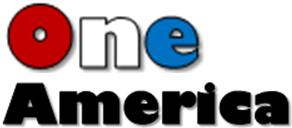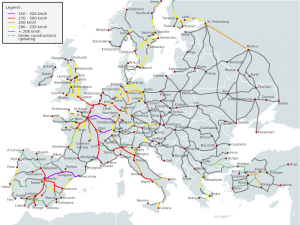 America should not have a world-class passenger rail system. America should have a world-aweing passenger rail system. Rail travel is central to American history. In fact, one reason our railways are so technologically behind those in other countries—where bullet trains reach speeds of 300+ km/hour—is that we Yanks started laying track so early.
America should not have a world-class passenger rail system. America should have a world-aweing passenger rail system. Rail travel is central to American history. In fact, one reason our railways are so technologically behind those in other countries—where bullet trains reach speeds of 300+ km/hour—is that we Yanks started laying track so early.
However, that’s only one reason. Other reasons include private sector profit impatience (no appreciation for long-term business goals) and a lack of political will to drive public investment. These all fall into the category Failure of Vision: people of vision no longer control the resources in the United States. We should really do something to remedy that, but in the meantime let me offer a new vision for US rail travel, which I call “One America.”
WHAT IS THE RAILWAY PARADIGM?
Anyone who has traveled Amtrak knows that there is an odd sense of being caught between two worlds, two other forms of travel. In some ways, the experience resembles inter-city air travel. In other ways, it resembles intra-city subway commuting.
And in most aspects, Amtrak fails to emulate the best examples presented by the two models, case by case. Take, for example, the old-fashioned method of checking tickets on board after the train has left the station. This is a silly and confusing archaism that should be abandoned in favor of the airport model of full gate screening.
On the other hand, the air travel paradigm of charging different amounts for different “classes” of seating makes little sense on a vehicle that can make a dozen stops between one’s departure and destination. Rail travelers already experience a pay differential based on distance traveled, and their seating comfort should simply reflect this. In fact, the cushioned, forward-facing, recliner seating that typifies Amtrak—which is reminiscent of jetliner seating—is a bit extravagant for short commutes.
Inter-city rail should incorporate subway-style commuter cars designed specifically for customers who expect to be on the train shorter than one hour, with very basic seating, no restrooms, and no diner car access. Not only would this save money on upkeep, but it would avoid the confusion of integrating short-commute customers into cars populated by longer commute travelers.
So, rather than distinguishing between “classes” of traveler by arbitrary, airline-style price inflation, a national rail service should separate travelers based on how long they expect to be on board. Where the thresholds lie between sleeper, high comfort, standard, and commuter class travel would need to be worked out, but the basic principle is sound and preferable to the current system based largely on economically wasteful positional value.
MANY COLORS, ONE COMMUNITY : E PLURIBUS UNUM
In one crucial aspect, a national rail system would do well to emulate metropolitan subway systems. Metro systems are relatively easy to understand and easy to take in at a glance; q.v. the New York, San Francisco, and Washington systems. They each clearly serve a single community, and are designed to convey a sense of unity for that community.
The current national rail system is a confusing mess of poetically named regional routes (like “Southwest Chief,” “Coast Starlight,” and “Empire Builder”) that overlap haphazardly and provide the new customer very few clues on how to schedule a trip. In contrast, most metro systems are color-coded, one color per line, with simple travel patterns.
American inter-city rail should adopt a color scheme similar to metro rail systems, and be reworked around a schedule designed to enable customers to think in terms of colors. To distinguish the national system from metropolitan systems, we should use the word “route” rather than “line” but the color schemes should be similar so they are familiar: Red, Blue, Yellow, Orange, Silver, etc.
To keep the color scheme simple, certain peripheral lines, like the “Vermonter,” should be identified as extensions of a main route. This is also similar to metro systems, in which certain subway lines vary in the extent of their reach while the colors remain the same. For example, DC’s Yellow Line sometimes stops at Fort Totten, sometimes at Greenbelt, but it remains the Yellow Line in either case.
ONE AMERICA : THE ROUTES
 Since mainland USA is basically a rectangle, I propose a rectangular grid scheme using our national colors of red, white, and blue for the main routes of the grid. Most of the routes described below rely on existing tracks, but others are proposed to complete the grid and fully connect America in one community.
Since mainland USA is basically a rectangle, I propose a rectangular grid scheme using our national colors of red, white, and blue for the main routes of the grid. Most of the routes described below rely on existing tracks, but others are proposed to complete the grid and fully connect America in one community.
Running laterally, the Red Route North would trace our northern frontier with Canada from Boston through Chicago to Washington State, while Red Route South would trace the southern frontier (including our border with Mexico) from Jacksonville through New Orleans and Houston to Los Angeles. The White Route would stretch across the middle of the country: from Washington, DC, through Indianapolis, Denver, and Salt Lake City to Sacramento.
A final east-west route, the Yellow Route, would connect Savannah, Atlanta, and Nashville to St. Louis along a proposed line, traveling on to Kansas City, Flagstaff, and San Bernardino on existing track.
Running north-south, the Blue Route Pacific would reach from Vancouver in Canada to San Diego, while the Blue Route Atlantic would reach from Boston to Orlando, connecting all the major cities in between, with extended routes connecting to Portland (Maine), Miami, and Tampa.
Other north-south routes based on existing lines would include: the Green Route connecting DC to Atlanta and New Orleans; the Purple Route connecting to the Chicago Hub, the White Route in Illinois, and the Yellow Route at Kansas City; the Silver Route connecting Chicago to the White in Illinois, the Yellow at St. Louis, through Dallas and Austin to San Antonio; and the Gold Route connecting Chicago to the White and Yellow in Illinois, through Memphis to New Orleans.
Proposed north-south routes would include: the Brown (or Bronze?) Route connecting Cleveland (home of the Browns) to the White Route in Cincinnati and Yellow in Nashville; the Black Route connecting Spokane with the White Route at Salt Lake City, through Las Vegas to the Yellow in California; and the Orange Route connecting Calgary with the Red-North in Montana, the White at Denver, and the Yellow in New Mexico.
UPGRADES AND EXPANSIONS
 Beyond merely establishing new routes and extensions, we need to put America back on top of the world by upgrading our rail system, not only to better serve our economy but also so we don’t look like cavemen compared to what exists in other countries.
Beyond merely establishing new routes and extensions, we need to put America back on top of the world by upgrading our rail system, not only to better serve our economy but also so we don’t look like cavemen compared to what exists in other countries.
Guess who’s planning to open high-speed rail hitting speeds of 320 kph (200 mph) in 2015? Morocco. America’s current top speed for passenger rail? Acela at a mere 240 kph (150 mph).
Also in 2015, Algeria will open high-speed rail comparable to Acela. Algeria. And Morocco. Think about that for a moment.
 China is planning multiple routes at 350 kph (possibly paying for it with interest on our debt) with Japan, South Korea, Saudi Arabia, Germany, France, Italy, Portugal, and Spain also planning routes topping 300 kph.
China is planning multiple routes at 350 kph (possibly paying for it with interest on our debt) with Japan, South Korea, Saudi Arabia, Germany, France, Italy, Portugal, and Spain also planning routes topping 300 kph.
Take a look at high-speed rail maps for Europe (right) and East Asia (left), then look at what passes for “vision” in the United States.
This is unacceptable. (So is this.)
In addition to more routes and faster routes, America should upgrade its passenger rail system with double-tracking. Most rail routes in the US today are single tracks, and trains moving in opposite directions have to pass each other using sidetracks: one of the trains has to sit idly while the other passes. Double-tracking more than doubles the number of trains/day that can use a given route, so the investment is a no-brainer if you intend to actually run trains in those newly opened usage slots. (And, with inter-city air travel being crowded to capacity, we might want to start using those slots.)
For example, to see how double-tracking can greatly improve a route’s usefulness and enable rail travel beyond, a 2007 study of the Chicago-St. Louis rail corridor (part of One America’s Silver Route) found that:
a single-track line, with optimal traffic control and signaling equipment, can accommodate a practical maximum of 30 trains per day if used by different types of trains. The maximum jumps to 75 trains if parallel tracks are available … Mark Davis, spokesman for the Union Pacific, confirmed that the single-track corridor between St. Louis and Chicago now has a capacity of 30 trains per day. Amtrak runs 10 trains a day, and the Union Pacific runs between two and five daily …
With that stretch of the Silver Route running a mere 12 to 15 trains of a possible upgraded 75, it is clear that upgrading all passenger to double tracks would simplify traffic management, enable increased speed even without high-speed rail improvements, and boost the number of possible travelers. (Not to mention the amount of freight.)
BOTTOM LINE
America should have not a world-class passenger rail system. We should have a world-surpassing passenger rail system.
Not only should we have a system that connect the nation as one community, but a system that other countries simply could not build. We’re the richest nation on Earth. There’s no reason we can’t do this, other than lack of vision, courage, and will.
